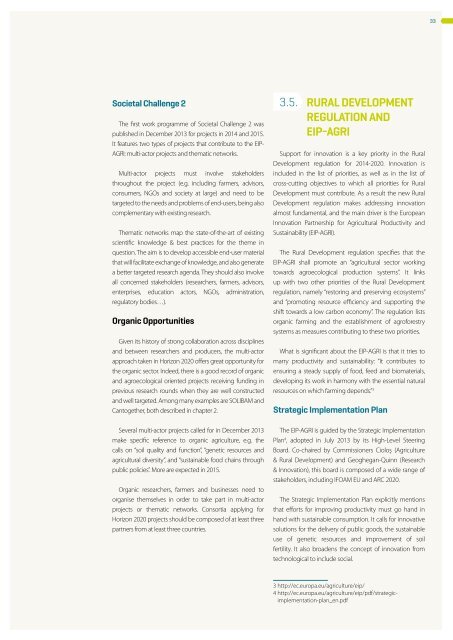tpo_dossier_action-plan-for-innovation-and-learning_201406
tpo_dossier_action-plan-for-innovation-and-learning_201406
tpo_dossier_action-plan-for-innovation-and-learning_201406
You also want an ePaper? Increase the reach of your titles
YUMPU automatically turns print PDFs into web optimized ePapers that Google loves.
33Societal Challenge 2The first work programme of Societal Challenge 2 waspublished in December 2013 <strong>for</strong> projects in 2014 <strong>and</strong> 2015.It features two types of projects that contribute to the EIP-AGRI: multi-actor projects <strong>and</strong> thematic networks.Multi-actor projects must involve stakeholdersthroughout the project (e.g. including farmers, advisors,consumers, NGOs <strong>and</strong> society at large) <strong>and</strong> need to betargeted to the needs <strong>and</strong> problems of end-users, being alsocomplementary with existing research.Thematic networks map the state-of-the-art of existingscientific knowledge & best practices <strong>for</strong> the theme inquestion. The aim is to develop accessible end-user materialthat will facilitate exchange of knowledge, <strong>and</strong> also generatea better targeted research agenda. They should also involveall concerned stakeholders (researchers, farmers, advisors,enterprises, education actors, NGOs, administration,regulatory bodies…).Organic OpportunitiesGiven its history of strong collaboration across disciplines<strong>and</strong> between researchers <strong>and</strong> producers, the multi-actorapproach taken in Horizon 2020 offers great opportunity <strong>for</strong>the organic sector. Indeed, there is a good record of organic<strong>and</strong> agroecological oriented projects receiving funding inprevious research rounds when they are well constructed<strong>and</strong> well targeted. Among many examples are SOLIBAM <strong>and</strong>Cantogether, both described in chapter 2.Several multi-actor projects called <strong>for</strong> in December 2013make specific reference to organic agriculture, e.g. thecalls on “soil quality <strong>and</strong> function”, “genetic resources <strong>and</strong>agricultural diversity”, <strong>and</strong> “sustainable food chains throughpublic policies”. More are expected in 2015.Organic researchers, farmers <strong>and</strong> businesses need toorganise themselves in order to take part in multi-actorprojects or thematic networks. Consortia applying <strong>for</strong>Horizon 2020 projects should be composed of at least threepartners from at least three countries.3.5.RURAL DEVELOPMENTREGULATION ANDEIP-AGRISupport <strong>for</strong> <strong>innovation</strong> is a key priority in the RuralDevelopment regulation <strong>for</strong> 2014-2020. Innovation isincluded in the list of priorities, as well as in the list ofcross-cutting objectives to which all priorities <strong>for</strong> RuralDevelopment must contribute. As a result the new RuralDevelopment regulation makes addressing <strong>innovation</strong>almost fundamental, <strong>and</strong> the main driver is the EuropeanInnovation Partnership <strong>for</strong> Agricultural Productivity <strong>and</strong>Sustainability (EIP-AGRI).The Rural Development regulation specifies that theEIP-AGRI shall promote an “agricultural sector workingtowards agroecological production systems”. It linksup with two other priorities of the Rural Developmentregulation, namely “restoring <strong>and</strong> preserving ecosystems”<strong>and</strong> “promoting resource efficiency <strong>and</strong> supporting theshift towards a low carbon economy”. The regulation listsorganic farming <strong>and</strong> the establishment of agro<strong>for</strong>estrysystems as measures contributing to these two priorities.What is significant about the EIP-AGRI is that it tries tomarry productivity <strong>and</strong> sustainability: “It contributes toensuring a steady supply of food, feed <strong>and</strong> biomaterials,developing its work in harmony with the essential naturalresources on which farming depends.” 3Strategic Implementation PlanThe EIP-AGRI is guided by the Strategic ImplementationPlan 4 , adopted in July 2013 by its High-Level SteeringBoard. Co-chaired by Commissioners Cioloș (Agriculture& Rural Development) <strong>and</strong> Geoghegan-Quinn (Research& Innovation), this board is composed of a wide range ofstakeholders, including IFOAM EU <strong>and</strong> ARC 2020.The Strategic Implementation Plan explicitly mentionsthat ef<strong>for</strong>ts <strong>for</strong> improving productivity must go h<strong>and</strong> inh<strong>and</strong> with sustainable consumption. It calls <strong>for</strong> innovativesolutions <strong>for</strong> the delivery of public goods, the sustainableuse of genetic resources <strong>and</strong> improvement of soilfertility. It also broadens the concept of <strong>innovation</strong> fromtechnological to include social.3 http://ec.europa.eu/agriculture/eip/4 http://ec.europa.eu/agriculture/eip/pdf/strategicimplementation-<strong>plan</strong>_en.pdf


